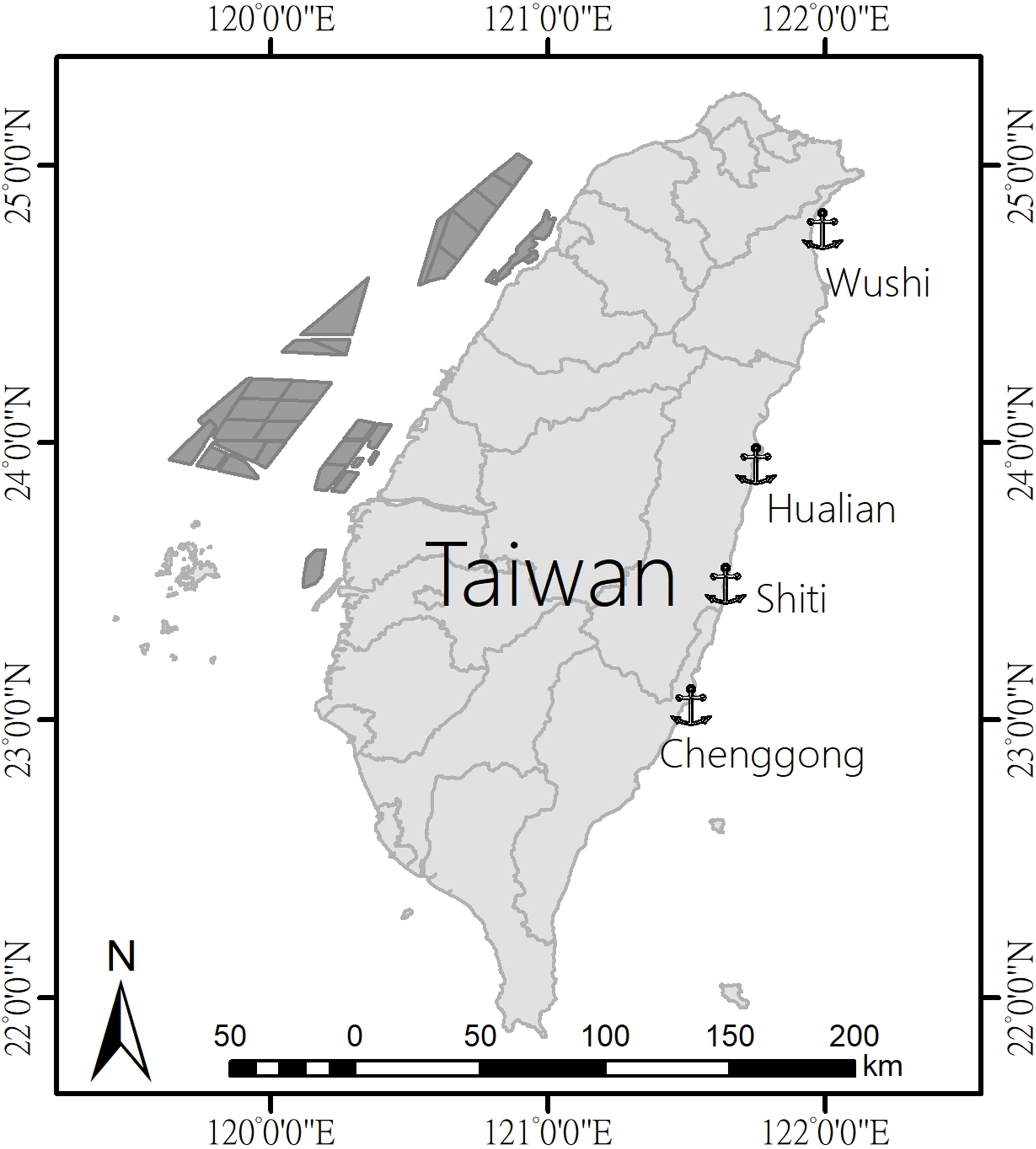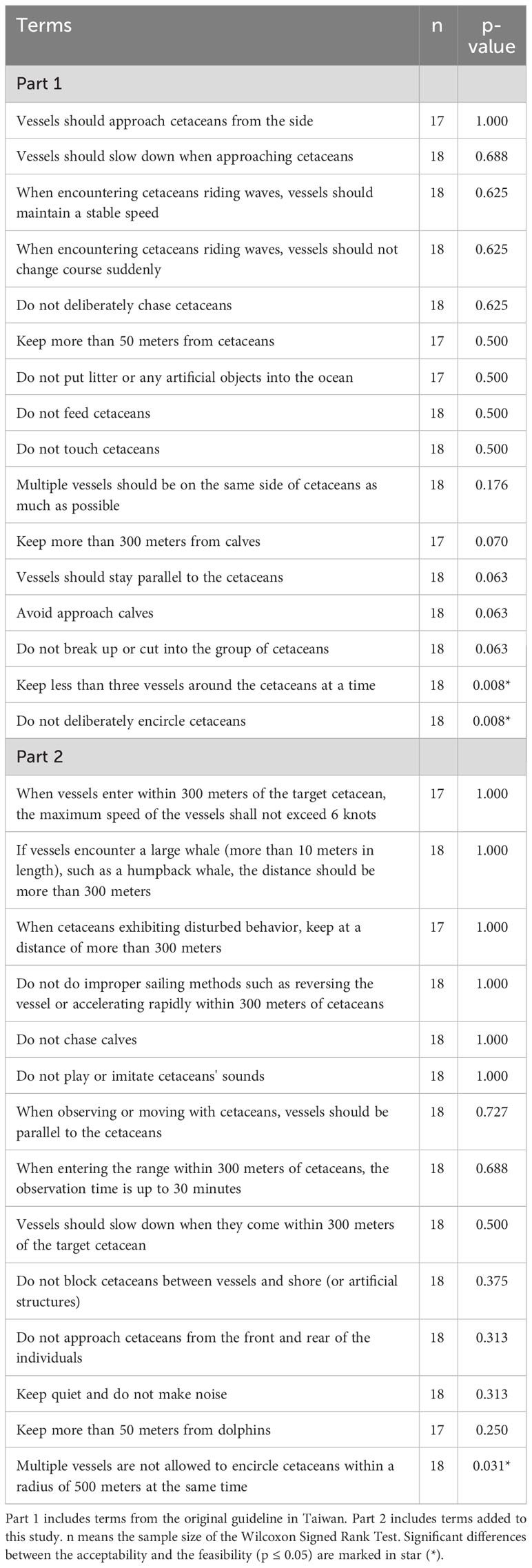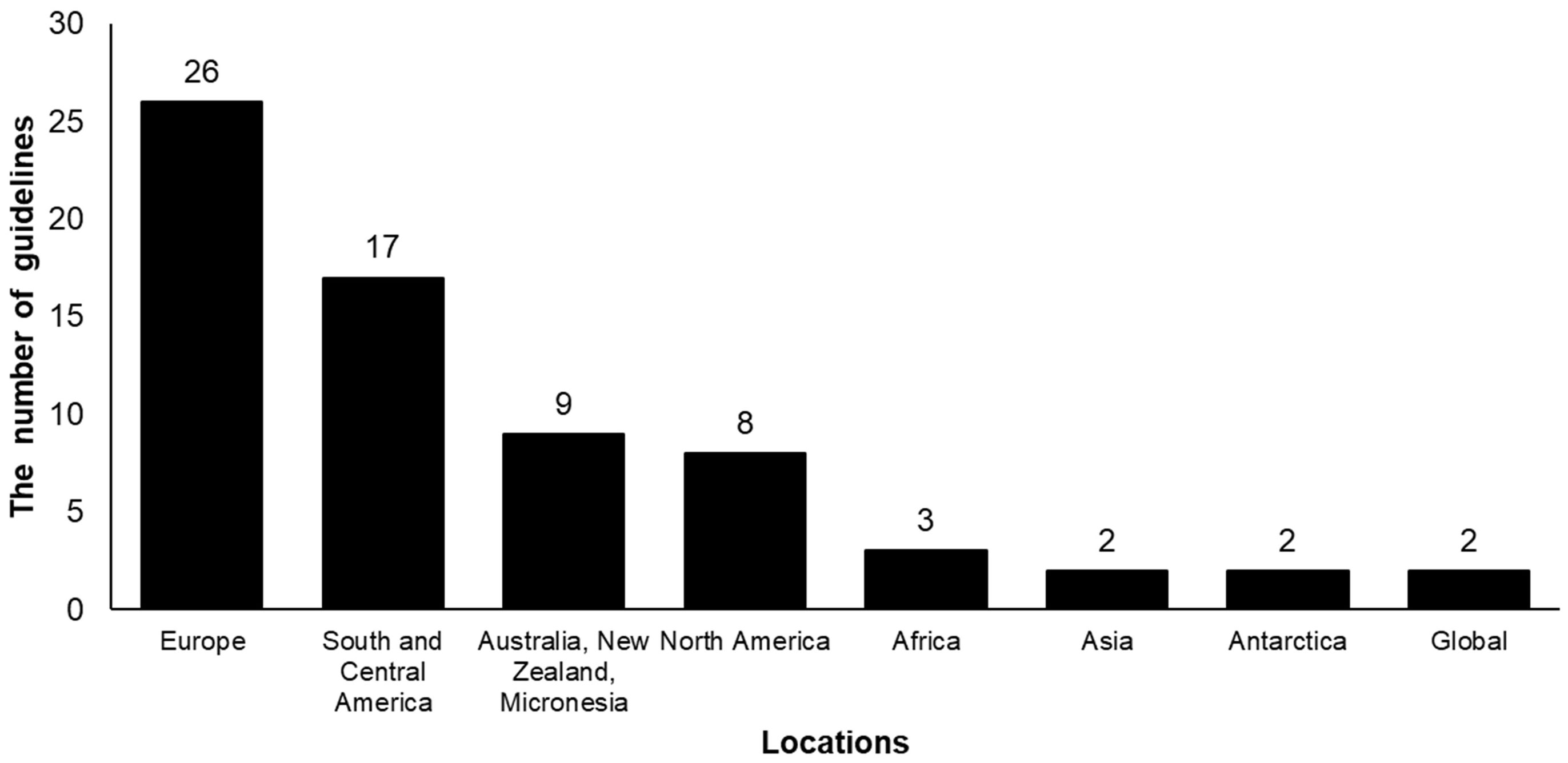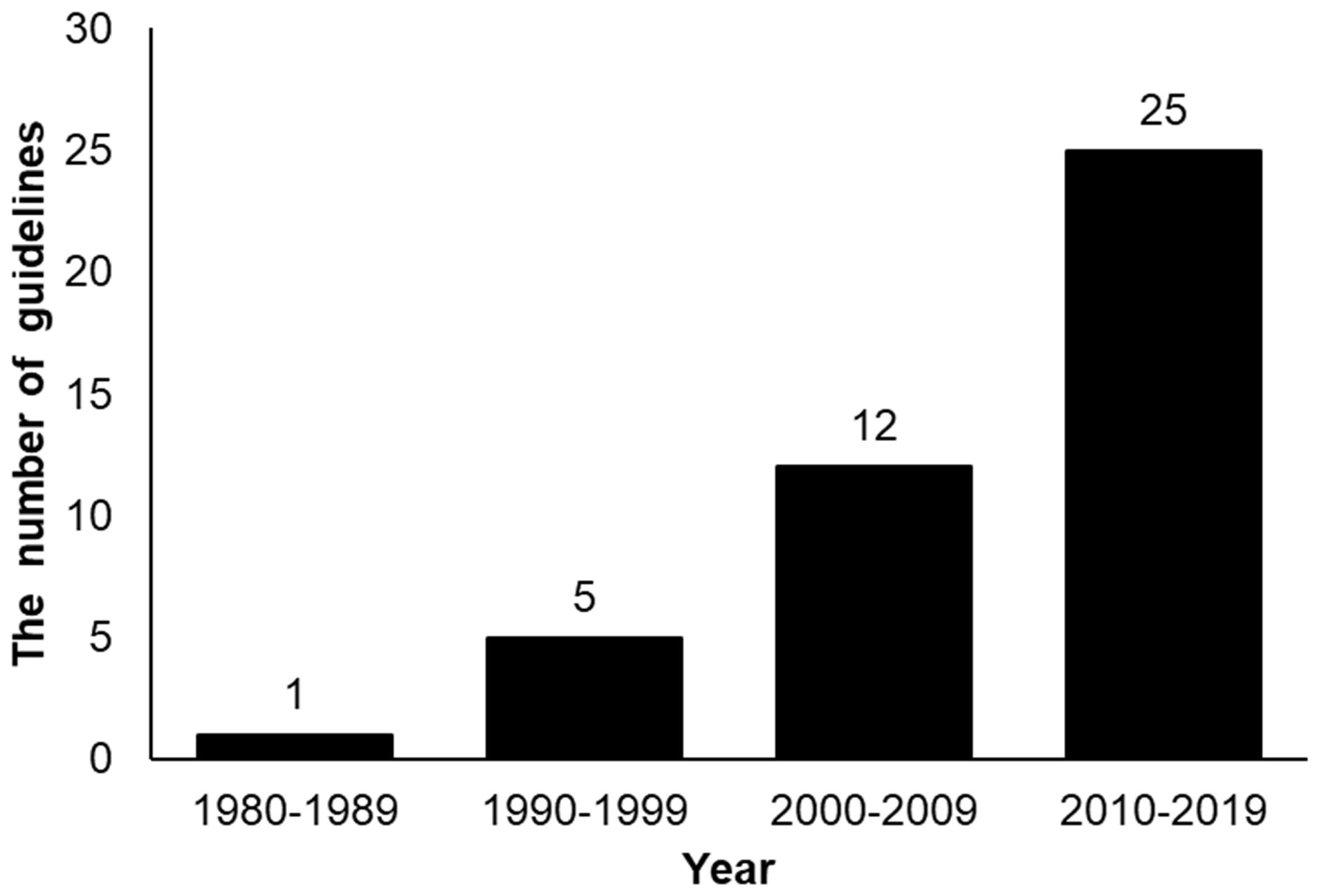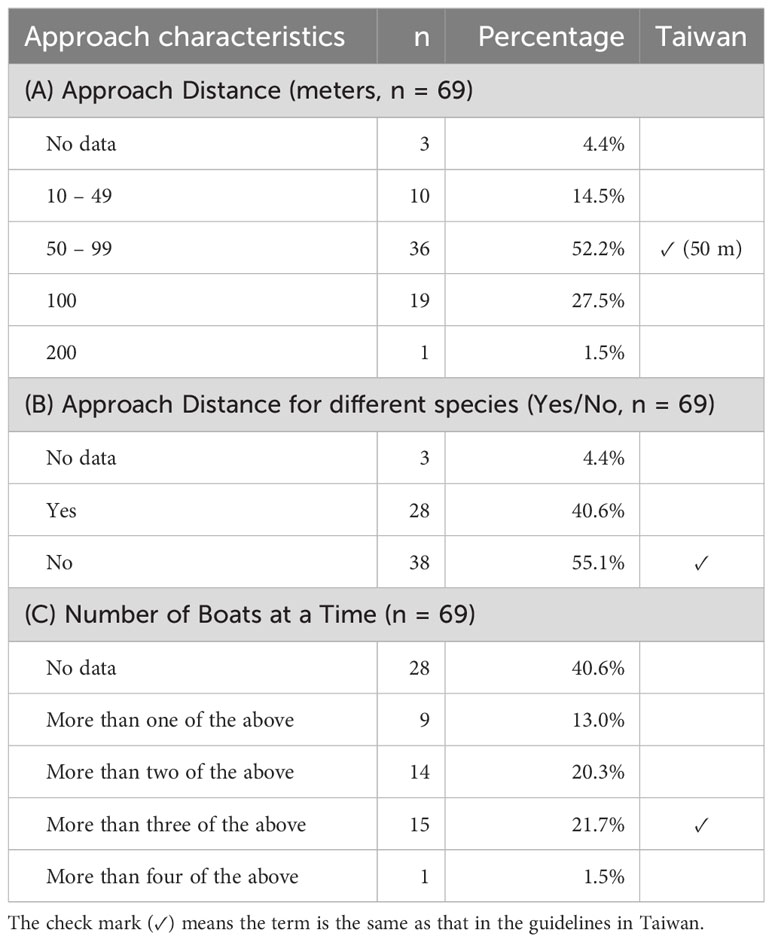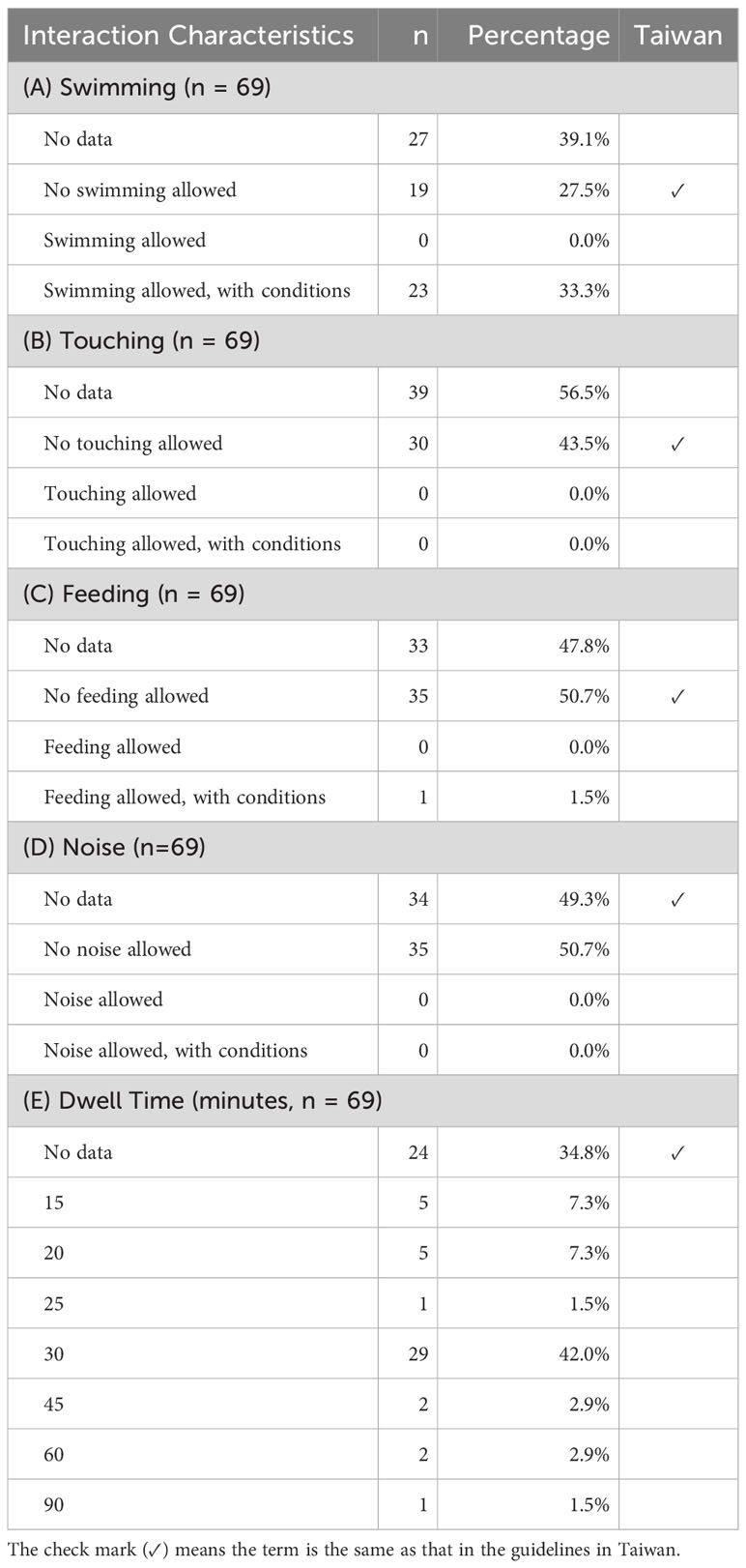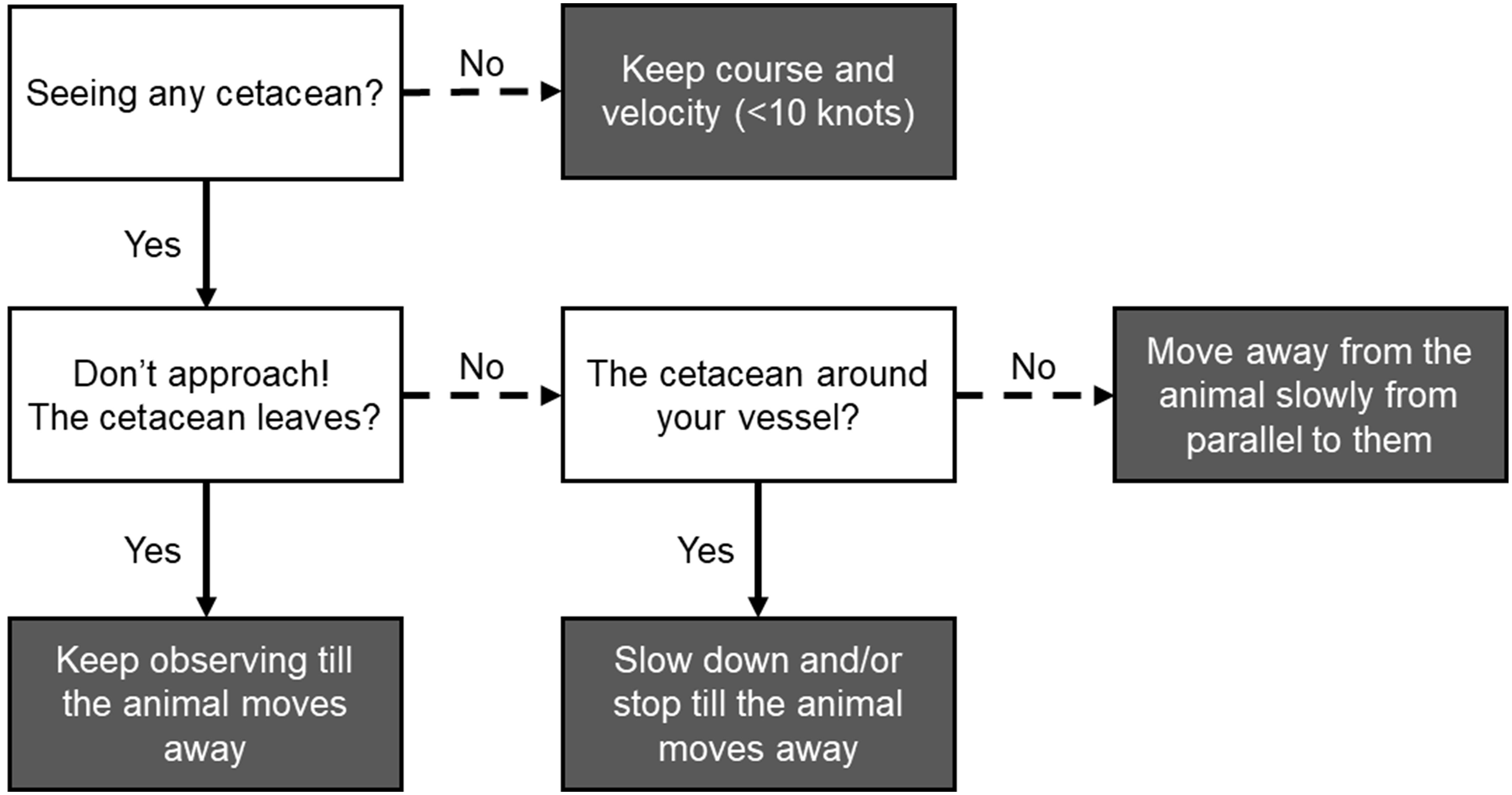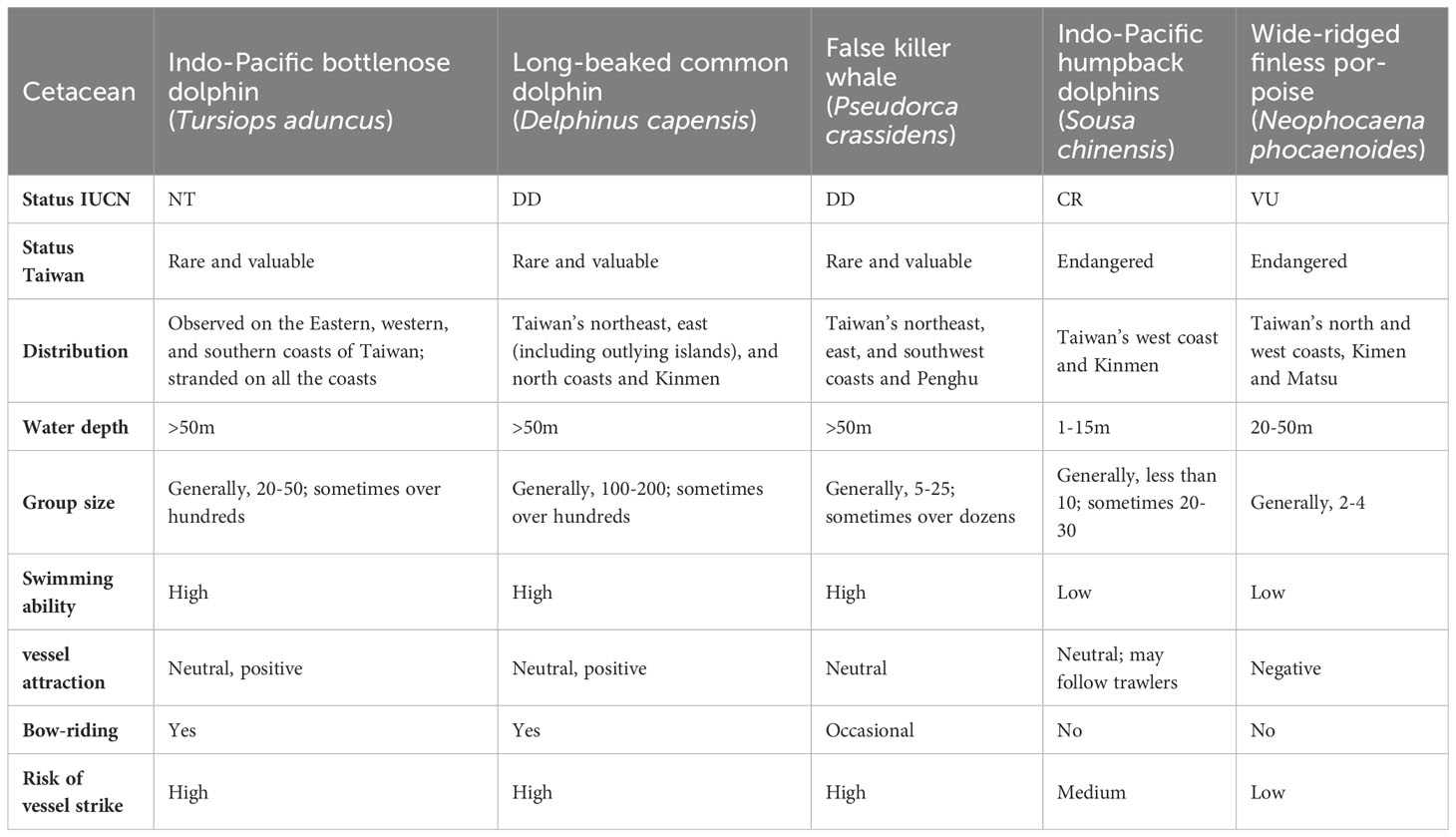- Center of Excellence for Ocean Engineering, National Taiwan Ocean University, Keelung, Taiwan
Developing offshore wind farms may impact cetaceans due to vessel collisions and underwater noise. Therefore, it is critical to protect cetaceans while developing offshore wind farms. We first studied the code of conduct/guidelines for whale watching and then interviewed members of the local whale-watching industry to learn about the interaction between cetaceans and vessels. After that, we compared current whale-watching guidelines in Taiwan with 69 published guidelines from other countries and locations, then developed guidelines for the offshore wind farm industry. The results show that rules related to approaching and interacting with cetaceans in Taiwan are similar to those in other countries. However, swimming with cetaceans and approaching calves are prohibited in Taiwan. From the survey of the whale-watching industry, most whale-watching guidelines in Taiwan were found to be feasible, and the guidelines should be described in the premise with different phenotypic traits of various cetaceans. Based on the whale-watching guidelines, we developed a code of conduct for protecting cetaceans from the impact of vessels, specifically in offshore wind farm operations in Taiwan.
Introduction
This study aimed to establish relevant codes of conduct in the operation of the wind farm industry for protecting cetaceans. The purpose is to manage boat activities to minimize the impact on cetaceans and achieve the goal of coexistence with cetaceans. Cetaceans are important in ecosystems and are under protection. According to the Red List of Threatened Species proposed by the International Union for Conservation of Nature (IUCN) in March 2021, there are more than 90 known species of cetaceans. The survival of cetaceans has been considered to play an important role in coping with global change (Sheehy et al., 2022). Cetaceans are high-grade consumers of their habitat ecosystems and are considered important indicators of maintaining ecosystems (Sousa et al., 2019). The life cycle of cetaceans has also been found to contribute to carbon fixation. When cetaceans excrete at the ocean’s surface, they provide phytoplankton nutrients, which can increase the fixed carbon (Sheehy et al., 2022). Cetaceans also store large amounts of carbon (Smith and Baco, 2003). When the cetaceans die and sink to the seafloor, a large amount of carbon stored in their bodies is brought to the seafloor (Sheehy et al., 2022). Therefore, for maintaining the sustainable development of human beings, it is important to maintain the sustainable development of cetaceans.
Cetacean diversity is high in the surrounding seas of Taiwan. According to the Marine Wildlife Conservation Division of the Ocean Conservation Administration (Ocean Conservation Administration, 2022), 33 cetacean species have been recorded around Taiwan (Table 1), approximately one-third of the cetacean species in the world. The underwater topography differs between the east and west of Taiwan, and different cetacean species inhabit it. The continental shelf of the eastern waters of Taiwan is narrow and steep, and the water depth along the coast rapidly drops over 2,000 meters. Many species of cetaceans have been observed, such as Risso’s dolphins (Grampus griseus), common bottlenose dolphins (Tursiops truncatus), pantropical spotted dolphins (Stenella attenuata), spinner dolphins (Stenella longirostris), and Fraser’s dolphins (Lagenodelphis hosei) (The Ichthyology Society of Taiwan, 2020), and there are even records of humpback whales (Megaptera novaeangliae) (Yu and Hu, 2023). Therefore, whale watching is a popular activity on the eastern coast. The continental shelf in the western water is wide and shallow, and the water depth is mostly within 100 meters. There are few relevant surveys and few records of cetacean species in comparison to the eastern waters. The common cetaceans in the western waters are the widely distributed Indo-Pacific bottlenose dolphins (Tursiops aduncus) and Indo-Pacific finless porpoises (Neophocaena phocaenoides) in wind farm areas and Indo-Pacific humpback dolphins (Sousa chinensis in shallower waters near the coast (Lee, 2006; Yang et al., 2021). Both the diversity and abundance of cetaceans are higher in the East than in the West.
With the diverse population of cetaceans along Taiwan’s east coast, whale-watching has become an important human activity in the region (Figure 1). Guidelines for interacting with these marine mammals have also been developed to ensure responsible and respectful interactions. The development of whale-watching tourism in Taiwan started at Shiti Fishing Port, Hualien, in July 1997. The number of tourists increased rapidly in the early years and slowed down around the year 2000 (Ku, 2013). The number of tourists was maintained at approximately 200,000 to 240,000 people annually from 2005 to 2009 (Ku, 2013). Then, it developed into an important tourism project with more than 460,000 visitors annually in 2016 (Chuang et al., 2020). Currently, whale-watching industries are present in several ports along the eastern coast of Taiwan, including Wushi Harbor, Hualien Harbor, Shiti, and Chenggong Harbor (Figure 1). However, while the industry is blooming, it also encountered situations similar to other countries with fast-growing whale-watching industries, i.e., the tourism impact on cetaceans (Pacheco et al., 2022). In order to ensure the coexistence of whale conservation and the whale-watching industry, it is essential to establish high-quality and sustainable whale-watching activities. Therefore, in May 2019, the Ocean Conservation Administration proposed “Whale-Watching Guidelines” for relevant businesses and tourists (Ocean Conservation Administration, 2019).
The offshore wind farm is also one of the human activities in Taiwan that was developed in the west of Taiwan (Figure 1). However, the guidelines for vessels in offshore wind farms are still being developed. There is a high potential for wind energy in the Taiwan Strait, and the government proposes to develop this renewable energy (Cheng et al., 2020). Offshore wind farms in Taiwan have been listed as one of the important development projects of the Ministry of Economic Affairs. The first offshore wind farm was completed and began operating in 2019, and there are more wind farms under construction and planning, mainly around the northeastern part of the Taiwan Strait (Figure 1). The increasing human activities in the ocean may negatively impact marine ecosystems as well as cetaceans, and the major effects of offshore wind farms on cetaceans are ship strikes (Schoeman et al., 2020) and underwater noise (Erbe et al., 2019). According to the records, at least 28 species of cetaceans have been documented to have been struck by vessels, ranging from larger species like baleen whales to smaller ones like toothed whales (reviewed in Schoeman et al., 2020). The impacts of ship strikes on whales and dolphins can be categorized into three types of consequences (Schoeman et al., 2020): (1) the direct consequences, i.e., immediate injuries or even death (Dwyer et al., 2014; Peel et al., 2018); (2) the long-term consequences, i.e., possible reduced fitness of an individual (Moore et al., 2013); and (3) the population consequences, i.e., a higher mortality rate than recruitment rate (Fais et al., 2016). Underwater noise is mainly caused by pile driving at wind turbine construction. This underwater noise may have various impacts on cetaceans, i.e., permanent/temporary hearing loss, masking, habitat displacement, and physiological effects (Thompson et al., 2013; New et al., 2015; Wright et al., 2020; Yang et al., 2021), thereby affecting the survival of individuals and groups (New et al., 2015; Forney et al., 2017). This study focused on preventing ship strikes.
To sum up, this study intends to formulate a guideline to protect cetaceans for vessel activities in Taiwan, especially regarding the impact of vessels on cetaceans. The whale-watching industry has great experience in the interactions between boats and cetaceans. We studied the whale-watching guideline/code of conduct by comparing international guidelines and surveying the whale-watching industry of Taiwan to learn the critical vessel-cetacean interaction, then applied the concept of friendly interaction to the guideline in offshore wind farms.
Materials and methods
Procedures
There are four conducting steps in this study. First, we collected and categorized cetacean-friendly guidelines for the whale-watching industry worldwide. Then, we compared the differences between the Taiwanese guidelines and guidelines from the rest of the world. After that, we surveyed Taiwan’s whale-watching industry to understand the practicality of the guidelines. Finally, we compiled a cetacean-friendly guideline for the operating vessels of offshore wind farms.
Guidelines collection and comparison
We searched the internet and solicited the advice of experts to identify guidelines/codes of conduct. The majority of the guidelines were collected from the database on the International Whaling Commission (IWC) website and the review paper of Carlson (2012), while few were from other sources. We followed Garrod and Fennell (2004) and classified terms in the guidelines into four categories: (1) general information (the published year and location of guidelines), (2) approaching characteristics (the way the vessels approach cetaceans), (3) interacting characteristics (the way the vessels and visitors interact with cetaceans), and (4) management orientation characteristics (the restrictions of reducing pollution and the disturbance to calves). Next, we scrutinized these terms by categories.
The cetacean-friendly guideline in Taiwan has been developed by the Ocean Conservation Administration (OCA) since 2018 and is announced on the website of OCA. We compared the terms mentioned in the guideline in Taiwan to other guidelines, focusing on their agreement and disagreement.
Surveys for the whale-watching industry
This study investigated the practicality of whale-watching guidelines, considering the level of acceptability and feasibility of implementing the guidelines. The acceptability is related to whether operators endorse these guidelines (Parsons, 2012). Previous research has shown that during the early stages of guideline development, higher rates are achieved when operators and relevant people are involved in the collaborative agreement and participation process (Parsons and Woods-Ballard, 2003). On the other hand, feasibility is primarily associated with the ease of dissemination (Scarpaci et al., 2004). Requirements that are easier to meet are more likely to be adopted and utilized by operators. When guidelines related to cetacean conservation are readily accepted and feasible to implement, the effectiveness of whale conservation efforts will be enhanced. In Taiwan, the OCA’s initial development of the whale-watching guidelines involved soliciting operator feedback. This study seeks to adjust the details of the whale-watching guidelines, and the experiences of relevant operators remain an integral part of this process.
We designed a questionnaire based on terms of Taiwanese guidelines. There were two parts to the questionnaire (Table 2): the first part included 16 terms from the Taiwanese guidelines, and the second part included 14 justified terms based on the Taiwanese guidelines. The questionnaire inquired whether the term is acceptable and feasible to abide by, using a scale of five points. The higher score meant the term was more acceptable and feasible to practice. We surveyed a total of 19 captains and tour guides from 13 whale-watching companies in 2022. There were 13 questionnaires from nine companies from Wushi, four questionnaires from three companies from Hualien, and two questionnaires from one company from Chenggong (Table S1).
Data analyses
In this study, we analyzed survey questionnaires to understand the acceptability and feasibility of the terms in the cetacean-friendly guideline in Taiwan. To assess whether there is a disparity between the level of acceptability and feasibility of whale-watching guidelines, we employed a non-parametric paired test, the Wilcoxon Signed Rank test. If a significant difference is observed, it indicates a disparity between the animal conservation concept and practice. JMP Pro 17 (SAS Institute Inc., Cary, NC, USA) was used for the data analysis in this study.
Results
The current situation of whale-watching guidelines
In addition to the Taiwanese guidelines, 69 cetacean-friendly guidelines for whale-watching were collected worldwide. The general information of these guidelines included the published location and year of the guidelines. We ranked their distribution based on the number of guidelines geographically (Figure 2). Europe ranks highest with 26 guidelines, which accounts for 37.7%. Central and South America ranks second with 17 guidelines, which accounts for 24.6%. Australia/New Zealand/Micronesia ranks third with nine guidelines, which accounts for 13.0%, followed by North America, which provides eight guidelines, accounting for 11.6%. The rest of the world, including Africa, Asia, and Antarctica, provides only nine guidelines.
There were 43 guidelines with the published year as known. The number of guidelines increases through years of whale-watching development (Figure 3). The increment is approximately doubled every ten years. It reached 25 guidelines, accounting for 36.2% in the period 2010-2019.
The characteristics of a vessel approaching may define an observing distance, i.e., the minimal distance between cetaceans and vessels. More than half of the guidelines, i.e., 36 guidelines, accounting for 52.2%, agree that the distance should be 50 to 99 meters (Table 3A). Again, more than half, i.e., 38 guidelines, accounting for 55.1% of the guidelines do not declare variation in observing distance based on various conditions, e.g., species, size, or mother-calf (Table 3B). Furthermore, 28 data entries (40.6%) specify minimum distances based on species or the size of cetaceans. The mainstream requirement for observing distance is at least 100 meters (17 entries), followed by a minimum of 200 and 300 meters (3 entries each) in the regions with large cetaceans. Most guidelines advocate that no more than three (21.7%) vessels can be around the cetaceans (Table 3C). The terms of the guidelines in Taiwan are consistent with the mainstream requirements. The distance between vessel and animal should be no less than 50 meters (no species difference), and no more than three vessels should be at this distance from the cetaceans.
The interacting characteristics in the guidelines include swimming with, touching, and feeding cetaceans, as well as noise regulation and observation time. Most guidelines conditionally allowed people to swim with cetaceans (23 guidelines, accounting for 33.3%, Table 4A), but neither touching (30 guidelines, accounting for 43.5%, Table 4B) nor feeding (35 guidelines, accounting for 50.7%, Table 4C) cetaceans is permitted. Most guidelines also prohibit making noise during whale-watching activities (50.7%, Table 4), and for the time of observation, most guidelines suggest that it should not exceed 30 minutes (42.0%, Table 4D). The Taiwanese guidelines do not permit people to swim with cetaceans, and of course, touching and feeding are not permitted either. The suggested observation time conforms with the mainstream guidelines throughout the world, not exceeding 30 minutes.
The management characteristics mainly included managing pollution/rubbish from vessels and/or visitors and conditional allowance of watching pods with calves. There were 25 guidelines (36.2%) on managing the state of pollution/rubbish (Table 5A), and most guidelines allowed people to watch pods with calves (40.6%, Table 5B) conditionally, e.g., keeping a longer minimum distance away, such as 200m. The Taiwanese guidelines also advocate the management of pollution/rubbish. However, there is no indication of noise. The Taiwanese guideline does not endorse people viewing pods with calves either.

Table 5 The summary of the management orientation characteristics from collected whale-watching guidelines.
The acceptability and feasibility of whale-watching guidelines
To assess the practicality of whale-watching guidelines based on the concept of cetacean conservation, we employed a questionnaire to analyze whether there are differences in whale-watching operators’ perceived acceptability and feasibility of guideline elements. If an item exhibits high acceptability and achievability scores with no significant differences, it can be inferred that it has high practicality. The interviewees left some questions regarding acceptability and feasibility unanswered. The number of valid responses for each question is indicated in Table 2. In the first part, wherein the questions were regarding the original terms of the whale-watching guidelines in Taiwan, interviewees presented positive attitudes (the range of the means of scores: 4.16-4.89) toward all terms in the whale-watching guideline. However, for the feasibility, the terms “no more than three vessels around the cetaceans at a time (Wilcoxon Signed Ranked Test, n = 18, p = 0.008)” and “do not encircle the cetaceans (Wilcoxon Signed Ranked Test, n = 18, p = 0.008)” were considered difficult to comply with (Table 2). In the second part, wherein the questions were added terms of the whale-watching in this study, interviewees presented positive attitudes (the range of the means of scores: 4.21-4.74) toward all terms in the whale-watching guidelines. However, for feasibility, the terms “do not encircle the cetaceans with multiple vessels within the 500 meters from animals (Wilcoxon Signed Ranked Test, n = 18, p = 0.031)” were considered difficult to comply with (Table 2).
The cetacean-friendly guideline for the vessels’ behavior in offshore wind farms
Based on experiences of interactions between vessels and cetaceans in the whale-watching industry and the information from the whale-watching guidelines, we compiled a cetacean-friendly guideline for vessel activity in offshore wind farms (Figure 4). While cruising, if no whales or dolphins are encountered, maintain a stable heading and velocity. If cetaceans are spotted, generally avoid approaching them actively. If the cetaceans voluntarily leave, continue observing them until they are at a distance. However, when the cetaceans do not voluntarily depart and are circling the vessel, reducing velocity or stopping the vessel and waiting for the cetaceans to depart is recommended. If the cetaceans are not circling the vessel, we suggested that the vessel slowly move away from the cetaceans on their side.
Following are descriptions of the guidelines.
1. Scenario of spotting cetaceans from afar
Cetaceans may be sighted from a distance. After spotting any cetacean, keep observing the behavior and swimming direction of the animals. The vessel maintains its original course if the animals ignore the vessel and swim away. Conversely, if the cetaceans move toward vessels initiatively, refer to the following conditions for encountering cetaceans nearby.
2. Scenario of encountering cetacean aside
Cetaceans may appear near the vessels suddenly or even actively race with a moving vessel, such as bow- or wake-riding, and may suddenly surround the vessel. The relevant considerations are listed below:
(1) The direction and velocity of the vessel
The vessel should stay as parallel to the cetacean as possible and change direction slowly. Also, slow down gently to leave from the side of the cetaceans. These procedures must keep as stable a velocity and direction as possible. Do not move to the position in front of or behind the cetaceans. It is important to provide exit routes for the cetaceans. Cetaceans may also lose interest and leave voluntarily when vessels slow down or stop.
(2) Do keep distance from cetaceans
In the offshore wind farms on the west coast of Taiwan, most of the cetaceans are small and medium-sized. Depending on their size, keep them at least 50 meters away. If there are calves, keep them at least 300 meters away.
(3) Do not actively interact with cetaceans
Do not make sounds to attract cetaceans and do not feed or touch them.
3. Precautious responses to encountering cetaceans
Cetacean encounters are rare events. There are no sightings of cetaceans most of the time in the ocean. When cetaceans are not spotted, to reduce the potential impacts on cetaceans during the voyage, the relevant precautions are listed below:
(1) Limitation of vessel velocity
During the months when cetaceans are observed often or when entering areas where cetaceans are more likely to appear, e.g., Wildlife Important Habitat Area for Indo-Pacific Humpback Dolphin (The Ichthyology Society of Taiwan, 2020), reduce vessel velocity below the fastest swimming speed of the cetaceans. Low vessel velocity can avoid collision with cetaceans, and low vessel velocity also reduces ship noise impact on cetaceans (Currie et al., 2017; Erbe et al., 2019; Schoeman et al., 2020).
(2) The limitation of noise
People on the vessels should not play sounds to interfere with the communication among individual cetaceans.
(3) The limitation of pollution
Do not dispose of food, garbage, or oil in the ocean.
Discussions
This study attempts to produce local guidelines for protecting cetaceans under the disturbances of human activities in the Taiwan ocean. An important element of the guidelines is self-governance. Self-governance is defined as a major resource for those involved in making and adapting guidelines over time (Ostrom, 1999) and has been considered to improve resource management in marine-related industries (Parsons et al., 2003; Lee and Rahimi Midani, 2015; Osmundsen et al., 2021). Therefore, in this study, we collected opinions from the local whale-watching companies, hoping to efficiently protect cetaceans, protect people, and protect the ecosystem. As a result, we discussed the comparison of whale-watching guidelines from different locations and the disparity between the people’s perceived acceptability and feasibility of the whale-watching guidelines. In addition, captains should log cetacean activities and practices for future adjustment of the guidelines.
Cetacean diversity in Taiwan
The surrounding waters of Taiwan host a diverse cetacean community. Among the 93 known species of cetaceans globally, there have been records of 33 species in the vicinity of Taiwan, including seven species of Balaenopteridae, one species of Eschrichtiidae, one species of Physeteridae, two species of Kogiidae, four species of Ziphiidae, Delphinidae (six species of Globicephalinae; 10 species of others), and two species of Phocoenidae (Table 1; summarized from Shao et al., 2020; Ocean Conservation Administration, 2022). In Taiwan, records of cetacean occurrence are primarily categorized into two main parts: sighting and stranding, with a few records dating back to the Japanese colonial period when captures were documented (Shao et al., 2020). Among these records, there is a wealth of sighting data along Taiwan’s eastern coast. The data are likely attributed to the development of whale-watching activities along Taiwan’s eastern coast, starting in 1997 (Chou, unpublished data). Through the growth of the whale-watching industry, there are many years’ worth of data that can be used to understand the distribution of cetaceans (Yu et al., 2019). Today, 27 different species of cetaceans have been recorded, through sightings or strandings, along Taiwan’s eastern coast. On the other hand, the cetacean record of the western coast of Taiwan primarily relies on stranding records, with sighting data gradually accumulating due to environmental assessments related to developments such as ports and offshore wind farms in recent years. Until now, 20 species of cetaceans have been recorded (on the western coast of Taiwan (Shao et al., 2022; Ocean Conservation Administration, 2022). The difference between cetacean fauna in the east and west is that in the west, it might be related to the oceanic topography and currents.
Human impacts on cetaceans
Cetacean stranding data has been recorded since 1994 and provides a great source for learning cetacean distribution in Taiwan (Yang et al., 2008; Li et al., 2021). Researchers have also started studying the potential impacts of human activities on cetaceans through the examination of stranded cetaceans. For example, the formation of bubbles in the cetacean’s middle ear might have been caused by sonar used during military activities in the Taiwan Strait that year (Yang et al., 2008). Li et al. (2021) also analyzed autopsy data from 73 stranded cetaceans and found that the stranding causes for eight individuals could be attributed to human activities such as bycatch, ship strikes, or related diseases caused by human activities. The blue whale carcass that washed ashore on the east coast of Taiwan in 2020 was investigated by the Marine Biology and Cetacean Research Center (MBCRC), National Cheng Kung University, and it was deduced that the whale had starved to death due to entanglement of fishing gear around its head (Marine Biology and Cetacean Research Center, 2020).
In addition to records of stranded cetaceans, through the examining physical injuries of live individuals, for example, using photo-ID techniques for the Indo-Pacific humpback dolphins, researchers can also assess the impact of human influences on live cetaceans. For instance, researchers discovered that over 30% of the 93 identifiable individuals (Wang et al., 2007; Slooten et al., 2013) and over 50% of the 78 identifiable individuals exhibited injuries possibly related to fishing interaction, i.e., bycatch or ship strikes (Wang et al., 2017).
Summarizing the above, human interference with cetacean conservation in the vicinity of Taiwan includes ship strikes, noise pollution, and entanglement in fishing gear.
The impact of whale watching on cetaceans
Humans’ utilization of cetacean resources has transitioned from historical whaling to relatively less impactful whale-watching activities. However, it is essential to continue addressing the disturbances caused by whale watching on cetaceans. Common contributing factors include vessel activities and the noise generated during whale watching (Guerra et al., 2014; Amrein et al., 2020). Previous research has indicated that cetacean behavior may be influenced when vessel frequency increases, such as shifting vocalization, leading to longer dive times and disruptions in activities such as feeding and nursing offspring. The common bottlenose dolphins were observed upward shifting their whistle with the presence of one or more vessels (Heiler et al., 2016). How vessels navigate, including their heading and velocity, plays a significant role. For instance, higher vessel velocity can increase the chances of colliding with cetaceans (Parsons, 2012). Improper vessel activities, separating cetacean groups, or restricting their movement paths can increase stress levels in cetaceans and potentially impact their physiological states, including their immune systems (Parsons, 2012; Cárdenas et al., 2021). These disturbances may affect cetacean habitat selection and, directly or indirectly, their survival (Barragán-Barrera et al., 2017). Therefore, it is essential to build guidelines for mitigating the impact of whale-watching activities on cetaceans.
Comparison of whale-watching guidelines
After integrating the collection of different whale-watching guidelines, geographically, there are more guidelines in Europe and America. This may be related to the maturity of tourism or the abundance of cetaceans. However, it can also be viewed as the sequence of regional development of the whale-watching industry. The very first whale-watching was conducted in California, USA, in the 1950s, then in European countries (New et al., 2015; Hoyt, 2021). Therefore, the result showed that sites in Europe and America had more guidelines than other regions, possibly due to the whale-watching industry being developed in Europe and America earlier. On the other hand, the distribution of the published year showed that the number of guidelines has increased since the 2000s. From this result, the appearance of cetacean conservation regulations may have fallen 20 to 25 years behind the beginning of the whale-watching industry. This illustrates the closely intertwined history of the development of whale-watching guidelines and the whale-watching industry in various regions.
By comparing the whale-watching guidelines between Taiwan and others, we found that most terms of the guidelines in Taiwan were similar to those in other sites. This also means that Taiwanese regulations are in agreement with international standards. However, there was something different due to different environments and cetacean species locally. Taiwanese guidelines do not allow people to swim with cetaceans, except to protect cetaceans; this is regarded as a safety measure for whale watchers (Rocha et al., 2022). Taiwanese guidelines also do not allow people to actively approach calves, therefore helping to reduce the interruption of cetacean breeding.
There were different applied scales in different whale-watching guidelines. Most of them were local (67 guidelines), and two of them were globalized. Comparing the terms of localized and globalized whale-watching guidelines, we can find some terms with basic principles of vessels’ behavior. For example, the vessels must keep a distance of at least 50 meters from dolphins and at least 100 meters from whales. The localized guidelines provide more details based on environmental or industrial backgrounds than the globalized guidelines. The distance limitations between vessels and cetaceans may be variable based on the body sizes of different cetaceans. Furthermore, increasing the feasibility, these adapted guidelines with the local environment or industrial culture have been found to increase the compliance of the local operators and the sustainability of whale-watching management (Amerson and Parsons, 2018).
The feasibility of whale-watching guidelines
In Taiwan, the interviewees of the whale-watching companies agreed with the concept of cetacean-friendly whale-watching for the sustainability of the whale-watching industry. However, a few terms could still be challenging to achieve, especially in Wushi, where the number of whale-watching boats is the highest in Taiwan. Moreover, the industries want to improve tourists’ satisfaction by increasing the chances of seeing cetaceans. Therefore, it could be harder to comply with the term “no more than three vessels around the cetaceans at a time.” In order to prevent or reduce conflicts between tourists and cetaceans, balancing tourists’ satisfaction and cetacean protection, whale-watching industries can use alternative methods to improve tourists’ satisfaction, such as applying environmental education on-board and during tours (Parsons and Brown, 2017). Tourists should acknowledge that watching cetaceans is not the only activity in whale-watching tours as there are many other activities related to the ocean to motivate customers. Whale-watching operators also emphasized that their itineraries now include introductions to the local ecology and culture, which allows tourists to understand that whale-watching activities are just one part of ecotourism. Additionally, they offer compensation in the form of discounts for tourists who do not spot cetaceans during their trip, encouraging them to return and explore marine ecosystems further. Consequently, ecotourism can be promoted with a more sustainable whale-watching tour.
Guidelines for vessels in offshore wind farm operation
Vessel guidelines for offshore wind farms were compiled based on the experiences of interactions between vessels and cetaceans related to whale-watching. However, there are differences between these two businesses. The most critical difference is that the wind farm industry does not search and watch cetaceans actively, with guidelines suggesting that velocity should be considered. Low vessel velocity is very important to mitigate collision risk. There was a positive relationship between the vessels’ velocity and the fatality rate of cetaceans when the velocity of the ship was over 10-12 knots on the east coast of the United States and Canada (Laist et al., 2001). With a 10-knot velocity limit for vessels in the United States, in the North Atlantic Right Whale Sanctuary, the simulation data showed that when the occurrence rate and mortality rate of right whales were highest, the mortality rate dropped by 22% after the velocity limit measures in winter (Crum et al., 2019). Even though the speed-limited vessels’ velocity is still faster than the average swimming velocity of right whales (0.39 meters per second, approximately 0.76 knots), the mitigation measure of reducing vessel velocity was still helpful in protecting cetaceans. The speed-reduced measure in small boats was regarded to help converse cetaceans (Schoeman et al., 2020), and when the speed of a small boat was not over 12.5 knots, the chances of being able to notice a humpback whale at over 300 meters were three times higher (Schoeman et al., 2020). Moreover, within 300 meters, the distance of noticing a humpback whale was also increased (Currie et al., 2017).
In Taiwan, cetacean-friendly whale-watching has been developed by the government since 2018 and is supported by the industry. The whale-watching guidelines are still adjusting according to the increased studies related to cetaceans in Taiwan. This experience from the whale-watching industry is suitable to be applied to the interaction between vessels and cetaceans in other industries. High vessel activity in the Taiwan Strait is expected because of the ambitious development of offshore wind farms. In this study, we recommend guidelines for offshore wind farm operations, evaluate the effectiveness of cetacean protection, and adjust the guidelines over time and across different contexts.
Vessel and cetaceans in offshore wind farm areas
Based on records from offshore wind farms, commonly observed cetacean species include the Indo-Pacific bottlenose dolphin, the long-beaked common dolphin, the false killer whale, the Indo-Pacific humpback dolphin, and the wide-ridged finless porpoise (Chen and Lee, preparing). Rarely, cetaceans belonging to Globicephalinae, Ziphiidae, and Balaenopteridae have also been observed in offshore wind farms. To assess the risk of ship strikes, we have summarized the specific traits of known cetacean species at offshore wind farms, including their behavior, ecological characteristics, and patterns of interaction with vessels in Table 6. We discussed the impact of the interaction patterns between cetaceans and vessels and then discussed how opportunities for encounters at sea and the swimming ability of the animals influence the possibility of the occurrence of ship strikes. Some cetaceans may actively approach vessels, riding the bow wave, potentially increasing the risk of ship collisions. Previous research on cetacean-vessel collisions has found that before such collisions occur, cetaceans often exhibit behaviors such as surfacing near the water’s surface or approaching the vessel (Ritter, 2012). In offshore wind farm areas, common dolphins like the Indo-Pacific bottlenose dolphin, long-beaked common dolphin, and false killer whale are often observed to approach vessels. Moreover, these species tend to form large groups. These characteristics suggest these cetaceans might be at a higher risk of vessel strikes. The physical condition of cetaceans, such as their swimming abilities, can influence their chances of being struck by vessels. For example, individuals with slower swimming speeds may have a poor ability to respond to approaching vessels, potentially increasing their risk of collision (Dolman et al., 2006). In Taiwan’s offshore wind farm areas, the endangered Indo-Pacific humpback dolphin and wide-ridged finless porpoise are less likely to approach vessels actively. However, they have poor swimming abilities. Especially in the case of the finless porpoise, it is difficult to spot them due to their cryptic behavior and lack of dorsal fins. Therefore, it is also essential to implement guidelines for vessel activity to reduce the risk of collisions. We also recommend that the guidelines in this study consider the characteristics of cetaceans living in this ocean and keep adjusting to updated survey data on cetaceans.
Data availability statement
The original contributions presented in the study are included in the article/Supplementary Material. Further inquiries can be directed to the corresponding author.
Ethics statement
Ethical review and approval was not required for the study on human participants in accordance with the local legislation and institutional requirements. Written informed consent from the participants was not required to participate in this study in accordance with the national legislation and the institutional requirements.
Author contributions
Both authors worked together and contributed equally in this study. Y-JC did most of the data collection and analyses. P-YL initiated the idea and manage the project. All authors contributed to the article and approved the submitted version.
Funding
The author(s) declare financial support was received for the research, authorship, and/or publication of this article. The study received funding from Changfang Wind Power Co., Ltd. and Xidao Wind Power Co., Ltd. The funders were not involved in the study design, collection, analysis, interpretation of data, the writing of this article or the decision to submit it for publication.
Conflict of interest
The authors declare that the research was conducted in the absence of any commercial or financial relationships that could be construed as a potential conflict of interest.
Publisher’s note
All claims expressed in this article are solely those of the authors and do not necessarily represent those of their affiliated organizations, or those of the publisher, the editors and the reviewers. Any product that may be evaluated in this article, or claim that may be made by its manufacturer, is not guaranteed or endorsed by the publisher.
Supplementary material
The Supplementary Material for this article can be found online at: https://www.frontiersin.org/articles/10.3389/fmars.2023.1215905/full#supplementary-material
References
Amerson A., Parsons E. C. M. (2018). Evaluating the sustainability of the gray-whale-watching industry along the Pacific coast of North America. J. Sustain. Tour. 26 (8), 1362–1380. doi: 10.1080/09669582.2018.1449848
Amrein A. M., Guzman H. M., Surrey K. C., Polidoro B., Gerber L. R. (2020). Impacts of whale watching on the behavior of humpback whales (Megaptera novaeangliae) onin the Coast of Panama. Front. Mar. Sci. 7. doi: 10.3389/fmars.2020.601277
Barragán-Barrera D. C., May-Collado L. J., Tezanos-Pinto G., Islas-Villanueva V., Correa-Cárdenas C. A., Caballero S. (2017). High genetic structure and low mitochondrial diversity in bottlenose dolphins of the Archipelago of Bocas del Toro, Panama: A population at risk? PloS One 12 (12), e0189370. doi: 10.1371/journal.pone.0189370
Cárdenas S., Gabela-Flores M. V., Amrein A., Surrey K., Gerber L. R., Guzmán H. M. (2021). Tourist knowledge, pro-conservation intentions, and tourist concern for the impacts of whale-watching in Las Perlas Archipelago, Panama. Front. Mar. Sci. 8. doi: 10.3389/fmars.2021.627348
Carlson C. (2012). A review of whale watch guidelines and regulations around the world version 2012. (Cambridge, UK: International Whaling Commission).
Chen Y. (2001). Ecological aspects of cetaceans in Ilan waters of Taiwan: abundance, distribution, habitat partitioning, and acoustics (Charleston, USA: University of Charleston).
Cheng K.-S., Ho C.-Y., Teng J.-H. (2020). Wind characteristics in the Taiwan Strait: a case study of the first offshore wind farm in Taiwan. Energies 13 (24), 6492. doi: 10.3390/en13246492
Chuang L. Z. H., Chen C.-L., Kung C.-W., Shih Y.-C. (2020). A nuisance at sea: Decoding tourists’ comfort on whale watching vessels. Ocean Coast. Manage. 184, 104915. doi: 10.1016/j.ocecoaman.2019.104915
Crum N., Gowan T., Krzystan A., Martin J. (2019). Quantifying risk of whale–vessel collisions across space, time, and management policies. Ecosphere 10 (4), e02713. doi: 10.1002/ecs2.2713
Currie J., Stack S., Kaufman G. D. (2017). Modelling whale-vessel encounters: the role of speed in mitigating collisions with humpback whales (Megaptera novaeangliae). J. Cetacean Res. Manage. 17 (1), 57–63. doi: 10.47536/jcrm.v17i1.431
Dolman S., Williams-Grey V., Asmutis-Silvia R., Isaac S. (2006). Vessel collisions and cetaceans: what happens when they don’t miss the boat. A WDCS Sci. Rep.
Dwyer S. L., Kozmian-Ledward L., Stockin K. A. (2014). Short-term survival of severe propeller strike injuries and observations on wound progression in a bottlenose dolphin. N. Z. J. Mar. Freshw. Res. 48 (2), 294–302. doi: 10.1080/00288330.2013.866578
Erbe C., Marley S. A., Schoeman R. P., Smith J. N., Trigg L. E., Embling C. B. (2019). The effects of ship noise on marine mammals—a review. Front. Mar. Sci. 6. doi: 10.3389/fmars.2019.00606
Fais A., Lewis T. P., Zitterbart D. P., Álvarez O., Tejedor A., Aguilar Soto N. (2016). Abundance and distribution of sperm whales in the Canary Islands: Can sperm whales in the Archipelago Sustain the current level of ship-strike mortalities? PloS One 11 (3), e0150660. doi: 10.1371/journal.pone.0150660
Forney K. A., Southall B. L., Slooten E., Dawson S., Read A. J., Baird R. W., et al. (2017). Nowhere to go: noise impact assessments for marine mammal populations with high site fidelity. Endanger. Species Res. 32, 391–413. doi: 10.3354/esr00820
Garrod B., Fennell D. A. (2004). An analysis of whale watching codes of conduct. Ann. Touris. Res. 31 (2), 334–352. doi: 10.1016/j.annals.2003.12.003
Guerra M., Dawson S. M., Brough T. E., Rayment W. J. (2014). Effects of boats on the surface and acoustic behaviour of an endangered population of bottlenose dolphins. Endanger. Species Res. 24 (3), 221–236. doi: 10.3354/esr00598
Heiler J., Elwen S. H., Kriesell H. J., Gridley T. (2016). Changes in bottlenose dolphin whistle parameters related to vessel presence, surface behaviour and group composition. Anim. Behav. 117, 167–177. doi: 10.1016/j.anbehav.2016.04.014
Ho Y., Wu P.-Y., Chou L.-S., Yang W.-C. (2023). Skin marks in critically endangered Taiwanese humpback dolphins (Sousa chinensis Taiwanensis). Animals 13 (4), 608. doi: 10.3390/ani13040608
Hoyt E. (2021). “Whale and dolphin watching in Europe,” in Under Pressure: the need to protect whales and dolphins in European waters (Switzerland: OceanCare).
Jefferson T.A., Webber M.A., Pitman R.L. (2015). “4 - Cetaceans,” in Marine Mammals of the World (Second Edition) eds. Jefferson T.A., Webber M.A., Pitman R.L. (San Diego: Academic Press), 24–357.
Ku S.-H. (2013). The Cognition of the Impact of Whale Watching on Whales in TAIWAN (Taiwan: Department of Tourism Management, Chinese Culture University). Available at: https://hdl.handle.net/11296/m3wzxn.
Laist D. W., Knowlton A. R., Mead J. G., Collet A. S., Podesta M. (2001). Collisions between ships and whales. Mar. Mamm. Sci. 17 (1), 35–75. doi: 10.1111/j.1748-7692.2001.tb00980.x
Lee P.-F. (2006). Taiwan's natural resources and ecology database – biodiversity (Taiwan: Forestry Bureau).
Lee S.-G., Rahimi Midani A. (2015). Fishery self-governance in fishing communities of South Korea. Mar. Pol. 53, 27–32. doi: 10.1016/j.marpol.2014.11.008
Li W.-T., Chou L.-S., Chiou H.-Y., Chen I.-H., Yang W.-C. (2021). Analyzing 13 years of cetacean strandings: Multiple stressors to cetaceans in Taiwanese waters and their implications for conservation and future research. Front. Mar. Sci. 8. doi: 10.3389/fmars.2021.606722
Marine Biology and Cetacean Research Center (2020). Marine Biology and Cetacean Research Center does its best to preserve the blue whale’ 'ss skeleton (Taiwan: National Cheng Kung University). Available at: https://web.ncku.edu.tw/p/404-1000-205895.php?Lang=enhttps://web.ncku.edu.tw/p/404-1000-205895.php?Lang=en.
Moore M. J., van der Hoop J., Barco S. G., Costidis A. M., Gulland F. M., Jepson P. D., et al. (2013). Criteria and case definitions for serious injury and death of pinnipeds and cetaceans caused by anthropogenic trauma. Dis. Aquat. Org. 103 (3), 229–264. doi: 10.3354/dao02566
New L. F., Hall A. J., Harcourt R., Kaufman G., Parsons E. C. M., Pearson H. C., et al. (2015). The modelling and assessment of whale-watching impacts. Ocean Coast. Manage. 115, 10–16. doi: 10.1016/j.ocecoaman.2015.04.006
Ocean Conservation Administration (2019) Whale-Watching Guidelines. Available at: https://www.oca.gov.tw/ch/home.jsp?id=14&parentpath=0,2&mcustomize=news_view.jsp&dataserno=127529.
Ocean Conservation Administration (2022) Whale-Watching Guidelines. Available at: https://www.oca.gov.tw/ch/home.jsp?id=192&parentpath=0,6,190.
Osmundsen T. C., Karlsen K. M., Robertsen R., Hersoug B. (2021). Shared waters—shared problems: The role of self-governance in managing common pool resources. Aquac. Econ. Manage. 25 (3), 275–297. doi: 10.1080/13657305.2020.1857468
Ostrom E. (1999). Self-governance and forest resources (USA: International Workshop on Community-Based Natural Resource Management (CBNRM). Available at: http://www.cbnrm.net/pdf/ostrom_001.pdf.
Pacheco A. S., Sepulveda M., Corkeron P. (2022). Whale-watching impacts: Science, human dimensions and management (Lausanne: Frontiers Media SA). doi: 10.3389/978-2-88971-440-7
Parsons E. C. M. (2012). The negative impacts of whale-watching. J. Mar. Biol. 2012, 807294. doi: 10.1155/2012/807294
Parsons E. C. M., Brown D. M. (2017). Recent advances in whale-watching research: 2015–2016. Tour. Mar. Environ. 12 (2), 125–137. doi: 10.3727/154427317X694728
Parsons E. C. M., Warburton C. A., Woods-Ballard A., Hughes A., Johnston P., Bates H., et al. (2003). Whale-watching tourists in West Scotland. J. Ecotourism 2 (2), 93–113. doi: 10.1080/14724040308668137
Parsons E., Woods-Ballard A. (2003). Acceptance of voluntary whalewatching codes of conduct in West Scotland: The effectiveness of governmental versus industry-led guidelines. Curr. Issues Tour. 6 (2), 172–182. doi: 10.1080/13683500308667950
Peel D., Smith J. N., Childerhouse S. (2018). Vessel strike of whales in Australia: The challenges of analysis of historical incident data. Front. Mar. Sci. 5. doi: 10.3389/fmars.2018.00069
Ritter F. (2012). Collisions of sailing vessels with cetaceans worldwide: First insights into a seemingly growing problem. J. Cetacean Res. Manage. 12 (1), 119–127. doi: 10.47536/jcrm.v12i1.598
Rocha D., Marley S.A., Drakeford B., Potts J., Gullan A. (2022). The benefits of guide training for sustainable cetacean-based tourism in developing countries, case study – Ponta do Ouro Partial Marine Reserve, Mozambique. Journal of Coastal Conservation 26 (4), 33. doi: 10.1007/s11852-022-00876-1
Ross P. S., Dungan S. Z., Hung S. K., Jefferson T. A., Macfarquhar C., Perrin W. F., et al. (2010). Averting the Baijibaiji syndrome: conserving habitat for critically endangered dolphins in Eastern Taiwan Strait. Aquat. Conserv.-Mar. Freshw. Ecosyst. 20 (6), 685–694. doi: 10.1002/aqc.1141
Scarpaci C., Nugegoda D., Corkeron P. J. (2004). No detectable improvement in compliance to regulations by “swim-with-dolphin” operators in Port Phillip Bay, Victoria, Australia. Tourism Mar. Environments 1 (1), 41–48. doi: 10.3727/154427304774865904
Schoeman R. P., Patterson-Abrolat C., Plön S. (2020). A global review of vessel collisions with marine animals. Front. Mar. Sci. 7. doi: 10.3389/fmars.2020.00292
Shao K.-T., Yu H.-Y., Yao, Yao C.-J., Su H., Lyu Y.-W., et al. (2020). One hundred marine animals in Taiwan (Taiwan: The Ocean Conservation Administration).
Sheehy J. M., Taylor N. L., Zwerschke N., Collar M., Morgan V., Merayo E. (2022). Review of evaluation and valuation methods for cetacean regulation and maintenance ecosystem services with the joint cetacean protocol data. Front. Mar. Sci. 9. doi: 10.3389/fmars.2022.872679
Slooten E., Wang J. Y., Dungan S. Z., Forney K. A., Hung S. K., Jefferson T. A., et al. (2013). Impacts of fisheries on the Critically Endangered humpback dolphin Sousa chinensis population in the eastern Taiwan Strait. Endanger. Species Res. 22 (2), 99–114. doi: 10.3354/esr00518
Smith C. R., Baco A. R. (2003). Ecology of whale falls at the deep-sea floor. Oceanography Mar. Biology Annu. Review. 41, 319–333.
Sousa A., Alves F., Dinis A., Bentz J., Cruz M. J., Nunes J. P. (2019). How vulnerable are cetaceans to climate change? Developing and testing a new index. Ecol. Indic. 98, 9–18. doi: 10.1016/j.ecolind.2018.10.046
The Ichthyological Society of Taiwan. (2020). Report on the results of the 2020 Huadong Sea Area Cetacean Population Survey Project. Commissioned by the Marine Wildlife Conservation Division of the Ocean Conservation Administration). Available at: https://www.oca.gov.tw/ch/home.jsp?id=220&parentpath=0&mcustomize=research_view.jsp&dataserno=202101280020.
Thompson D., Hall A., Lonergan M., McConnell B., Northridge S. (2013). Current status of knowledge of effects of offshore renewable energy generation devices on marine mammals and research requirements. (Edinburgh, UK: Report to Scottish Government; Scottish Government).
Wang J. Y. (2000). Cetaceans in the waters of Kenting National Park and adjacent regions of southern Taiwan (Kengting, Taiwan: Kenting National Park Conservation Research Report 107). 50pp.
Wang J., Araújo-Wang C. (2018). Sousa chinensis ssp. Taiwanensis (amended version of 2017 assessment). IUCN Red List Threatened Species 2018, eT133710A122515524. doi: 10.2305/IUCN.UK.2017-3.RLTS.T133710A122515524.en
Wang J. Y., Chu Yang S., Hung S. K., Jefferson T. A. (2007). Distribution, abundance and conservation status of the eastern Taiwan Strait population of Indo-Pacific humpback dolphins, Sousa chinensis. Mammalia, 157–165. doi: 10.1515/MAMM.2007.032
Wang J. Y., Hung S. K., Yang S.-C. (2004). Records of Indo-Pacific humpback dolphins, Sousa chinensis(Osbeck 1765), from the waters of western Taiwan. Aquat. Mamm. 30 (1), 189–196. doi: 10.1578/AM.30.1.2004.125
Wang J. Y., Riehl K. N., Yang S. C., Araújo-Wang C. (2017). Unsustainable human-induced injuries to the Critically Endangered Taiwanese humpback dolphins (Sousa chinensis Taiwanensis). Mar. pollut. Bull. 116 (1-2), 167–174. doi: 10.1016/j.marpolbul.2016.12.080
Wright A. J., Araújo-Wang C., Wang J. Y., Ross P. S., Tougaard J., Winkler R., et al. (2020). How ‘blue’ is ‘green’ energy? Trends Ecol. Evol. 35 (3), 235–244. doi: 10.1016/j.tree.2019.11.002
Yang W.-C., Chen C.-F., Chuah Y.-C., Zhuang C.-R., Chen I.-H., Mooney T. A., et al. (2021). Anthropogenic sound exposure-induced stress in captive dolphins and implications for cetacean health. Front. Mar. Sci. 8. doi: 10.3389/fmars.2021.606736
Yang W.-C., Chou L. S., Jepson P. D., Brownell R. L. Jr., Cowan D., Chang P. H., et al. (2008). Unusual cetacean mortality event in Taiwan, possibly linked to naval activities. Vet. Rec. 162 (6), 184–186. doi: 10.1136/vr.162.6.184
Yu H.-Y., Chen I., Li W.-T., Chou L.-S. (2019). Ecological and biological characteristics for the Risso's dolphins (Grampus griseus) off Taiwan, with conservation evaluations on potential anthropogenic threats. Mamm. Study 44 (2), 77–89. doi: 10.3106/ms2018-0038
Yu H.-Y., Hu J.-C. (2023). World Whale Day! Explore the past 23 years of sighting records of baleen whales in Hualien waters (Kuroshio Ocean Education Foundation: Kuroshio Ocean Education Foundation). Available at: https://www.kuroshio.org.tw/newsite/article02.php?info_id=906.
Keywords: cetacean, whale watching, offshore wind farm (OWF), vessel guideline, sustainability
Citation: Chen Y-J and Lee P-Y (2023) Developing cetacean-friendly guidelines, from whale watching to offshore wind farm operation. Front. Mar. Sci. 10:1215905. doi: 10.3389/fmars.2023.1215905
Received: 02 May 2023; Accepted: 30 October 2023;
Published: 30 November 2023.
Edited by:
Vitor H. Paiva, University of Coimbra, PortugalReviewed by:
Salvatore Siciliano, Fundação Oswaldo Cruz (Fiocruz), BrazilManuela Bassoi, Federal University of Rio Grande do Norte, Brazil
Copyright © 2023 Chen and Lee. This is an open-access article distributed under the terms of the Creative Commons Attribution License (CC BY). The use, distribution or reproduction in other forums is permitted, provided the original author(s) and the copyright owner(s) are credited and that the original publication in this journal is cited, in accordance with accepted academic practice. No use, distribution or reproduction is permitted which does not comply with these terms.
*Correspondence: Pey-Yi Lee, cGV0ZXJsZWVAbWFpbC5udG91LmVkdS50dw==
 Yu-Ju Chen
Yu-Ju Chen Pey-Yi Lee
Pey-Yi Lee
